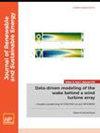Performance analysis and configuration method optimization of AA-CAES-based air storage tanks
IF 1.9
4区 工程技术
Q4 ENERGY & FUELS
引用次数: 0
Abstract
To improve the performance of the compressed air energy storage (CAES) system, flow and heat transfer in different air storage tank (AST) configurations are investigated using numerical simulations after the numerical model has been experimentally validated. System performance for different AST placement methods is analyzed through numerical simulations integrated with the thermodynamic model of advanced adiabatic compressed air energy storage (AA-CAES). An in-depth study examines the impact of key system parameters on system performance with different AST configurations. Based on these analyses, the AA-CAES system with a constant volume of AST is optimized. The results indicate that horizontal placement of the AST improves heat transfer capability within the same working pressure range but results in slightly lower energy storage efficiency, achieving 64.61% compared to 65.50% for vertical placement. However, horizontal placement offers higher energy storage density, achieving 3.54 kW h/m3 under specific conditions, compared to 3.14 kW h/m3 for vertical placement. As the energy storage flow rate increases, exceeding the critical flow rate significantly improves heat transfer in vertically placed ASTs, thus narrowing the energy storage density gap between configurations. Increased turbine efficiency, additional external heat sources, and further utilization of compression heat provide more significant performance improvements for the AA-CAES with the AST placed horizontally compared to vertically. Compared to the AA-CAES with vertically placed ASTs, the configuration of the ASTs is optimized to enhance the electrical output of the AA-CAES by 76.4 MW h and reduce the input by 78.9 MW h at a storage flow rate of 0.5 kg/s.基于 AA-CAES 的储气罐性能分析和配置方法优化
为了提高压缩空气储能(CAES)系统的性能,在对数值模型进行实验验证后,利用数值模拟研究了不同空气储气罐(AST)配置中的流动和传热情况。通过与先进绝热压缩空气储能(AA-CAES)热力学模型相结合的数值模拟,分析了不同 AST 布置方法的系统性能。深入研究了不同 AST 配置下关键系统参数对系统性能的影响。在这些分析的基础上,对具有恒定 AST 容积的 AA-CAES 系统进行了优化。结果表明,在相同的工作压力范围内,水平放置 AST 可提高传热能力,但储能效率略低,仅为 64.61%,而垂直放置则为 65.50%。不过,水平放置的储能密度更高,在特定条件下可达到 3.54 kW h/m3,而垂直放置的储能密度为 3.14 kW h/m3。随着储能流速的增加,超过临界流速将显著改善垂直放置 AST 的热传递,从而缩小配置之间的储能密度差距。与垂直放置的 AST 相比,涡轮机效率的提高、额外外部热源的增加以及压缩热的进一步利用为 AA-CAES 提供了更显著的性能改进。与垂直放置 AST 的 AA-CAES 相比,AST 的配置经过优化,在 0.5 千克/秒的存储流量条件下,AA-CAES 的电力输出提高了 76.4 兆瓦时,输入减少了 78.9 兆瓦时。
本文章由计算机程序翻译,如有差异,请以英文原文为准。
求助全文
约1分钟内获得全文
求助全文
来源期刊

Journal of Renewable and Sustainable Energy
ENERGY & FUELS-ENERGY & FUELS
CiteScore
4.30
自引率
12.00%
发文量
122
审稿时长
4.2 months
期刊介绍:
The Journal of Renewable and Sustainable Energy (JRSE) is an interdisciplinary, peer-reviewed journal covering all areas of renewable and sustainable energy relevant to the physical science and engineering communities. The interdisciplinary approach of the publication ensures that the editors draw from researchers worldwide in a diverse range of fields.
Topics covered include:
Renewable energy economics and policy
Renewable energy resource assessment
Solar energy: photovoltaics, solar thermal energy, solar energy for fuels
Wind energy: wind farms, rotors and blades, on- and offshore wind conditions, aerodynamics, fluid dynamics
Bioenergy: biofuels, biomass conversion, artificial photosynthesis
Distributed energy generation: rooftop PV, distributed fuel cells, distributed wind, micro-hydrogen power generation
Power distribution & systems modeling: power electronics and controls, smart grid
Energy efficient buildings: smart windows, PV, wind, power management
Energy conversion: flexoelectric, piezoelectric, thermoelectric, other technologies
Energy storage: batteries, supercapacitors, hydrogen storage, other fuels
Fuel cells: proton exchange membrane cells, solid oxide cells, hybrid fuel cells, other
Marine and hydroelectric energy: dams, tides, waves, other
Transportation: alternative vehicle technologies, plug-in technologies, other
Geothermal energy
 求助内容:
求助内容: 应助结果提醒方式:
应助结果提醒方式:


